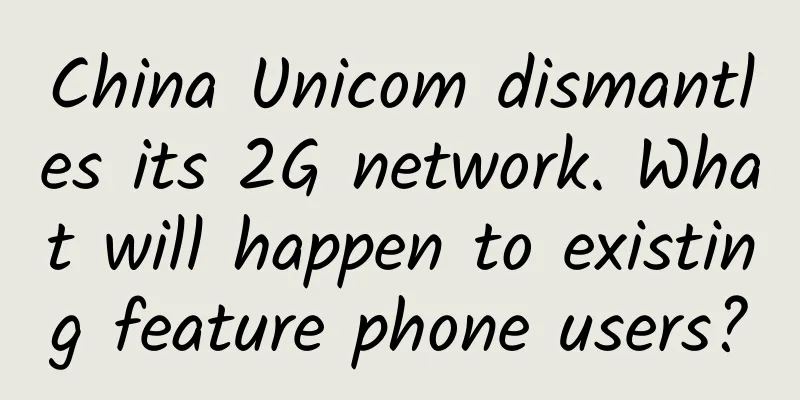China Unicom dismantles its 2G network. What will happen to existing feature phone users?

|
According to official information from China Unicom, China Unicom Fujian Company and Henan Xinxiang Branch will start the removal and decommissioning of old equipment such as 2G in the entire region in the near future. In fact, in early April, China Unicom Guangzhou Branch started the removal and decommissioning of 2G equipment. Although the withdrawal of 2G network is both a technological trend and a general trend, what should be done with the large number of 2G users on the network? Currently, most of the users of 2G network are feature phones and are mainly elderly users. How should the communication needs of these people be met after the withdrawal of 2G network? 1. The scale of existing 2G users exceeds expectations The latest data from the Ministry of Industry and Information Technology shows that by the end of May, there were 1.592 billion mobile phone users in my country, of which 1.319 billion were mobile Internet (3G+4G) users. Based on this data, we calculated that there were 273 million 2G users in the country, accounting for about 17.15% of all mobile phone users, slightly less than one-fifth, a scale that still exceeded many people's expectations. Based on the current proportion of mobile phone users of the three major operators, we roughly estimate that China Unicom has about 51.5 million 2G users. Although 51.5 million is insignificant compared to the country's total population of 1.4 billion, this number not only exceeds the total population of many countries, but most of them belong to the disadvantaged group with poor economic ability. Although it has been more than 11 years since 3G was licensed and commercially available, and more than 6 years since 4G was licensed and commercially available, 2G users have not completely disappeared as the scale of 3G+4G users continues to increase. This is due to both the uneven economic development of various regions and the fact that 2G network coverage is too good. After all, my country's 2G network is the mobile communication network with the best coverage in the world. 2. Promoting the replacement of existing 2G users is essential As early as two years ago, the three major operators including China Unicom jointly launched a large-scale 2G user migration project with terminal manufacturers. Operators tried to migrate all existing 2G users to the 4G network with ultra-low-priced 4G packages and ultra-low-priced 4G terminals. Given the current large number of existing 2G users, this work needs to be urgently promoted. According to our survey, the existing 2G users are mostly in remote mountainous areas or rural areas. On the one hand, local economic conditions limit the communication consumption capacity of these users, and on the other hand, there are still large gaps in 4G network coverage in remote areas. These are objective factors for the existence of 2G users. Operators' cessation of 2G network services will not only help them focus their energy and resources on promoting high-quality development of 5G, but will also objectively save them a lot of construction and maintenance funds. From the perspective of safeguarding the vital interests of the people, it is necessary for operators to provide preferential solutions to help existing 2G users migrate to 4G networks. 3. Network upgrade has become an unavoidable topic The current 5G competition has become the focus of countries to demonstrate their technological strength. In the race to be the global leader in 5G, Chinese operators have already taken the lead in the world. The scale of 5G base stations of China Mobile alone is already the largest in the world. If China Unicom and China Telecom 5G base stations are added, the total number of 5G base stations in my country will inevitably further widen the gap with the second place. Although my country's operators have achieved phased results in the global 5G competition, it cannot be ignored that the three major operators are still burdened with the vast majority of 2G and 3G network baggage. Data released by the Ministry of Industry and Information Technology show that the total number of 2G and 3G users in my country is about 300 million. In order to meet the communication needs of these users, operators have to spend huge resources to maintain smooth communication. China Unicom's large-scale removal of 2G network equipment is actually what China Mobile and China Telecom want to do. It can be said that as the construction of 5G networks continues to increase, operators will have a stronger demand to remove 2G and 3G network equipment. Between the trade-off between local interests and overall interests, we believe that the overall interests are the common interests of everyone. Of course, helping existing 2G and 3G users migrate to 4G and 5G networks is also the unavoidable responsibility of operators. There are a lot of discussions on the Internet about operators stopping 2G and 3G network services. Although the regulators have not yet made a clear statement on how to protect the communication rights of existing 2G and 3G users, we hope that operators can fully consider the vital interests of existing users and help these users migrate by providing a variety of preferential plans. |
<<: Inspur Networks launches new Wi-Fi 6 products to enable the era of fully “wireless” IoT
>>: 9 classic cases, online teaching how to troubleshoot network failures
Recommend
Can't tell the difference between Wi-Fi and WLAN? Stop confusing them
Usually, we connect to WiFi when we surf the Inte...
How many hurdles will computing power development have to overcome in the future?
At present, the digital economy is entering a new...
spinservers: $89/month - Dual E5-2630, 128G memory, 4*2TB hard drives, 10Gbps bandwidth, San Jose & Dallas data centers
spinservers has released this month's promoti...
DigitalVirt: Los Angeles AS9929 line starting at 245 yuan/year, 1GB/20G NVMe/1TB monthly traffic
DigitalVirt recently launched a new promotion, wh...
What are public IP and private IP? What is NAT conversion?
1. Introduction Programmers who develop network c...
Huawei releases OptiXstar Gigabit Smart Optical Modem flagship product to create six-star quality home broadband in the F5G era
[Shenzhen, China, March 30, 2020] Today, Huawei o...
Things about WKWebView on iOS
[[413463]] Background Students who are familiar w...
LigaHosting: Netherlands/Sweden/Moldova/Thailand/Dallas VPS monthly payment starts from 1.99 euros
LigaHosting.ro is a Romanian hosting company that...
How is the world's largest OpenRAN operator doing?
On February 14, Japanese operator Rakuten Mobile ...
How to move your contact center to the cloud to prepare for the pandemic
The coronavirus outbreak has had an unprecedented...
How long will it take for 5G to be fully commercialized? Why?
Recently, a netizen asked, how long will it take ...
Will 5G become a new springboard for domestic cloud computing giants to surpass international giants?
As an important member of the new infrastructure ...
After three years of cooperation, Huawei and Beijing Ruicheng Times have created a new name card for smart cities
[51CTO.com original article] As soon as I walked ...
Digital China is moving towards a deeper and more practical digital economy.
"Vigorously develop the digital economy, imp...
RAKsmart adds Hong Kong large bandwidth and 20% discount promotion, US/Hong Kong/Japan cluster server 258 IP
RAKsmart has added a new Hong Kong high-bandwidth...









